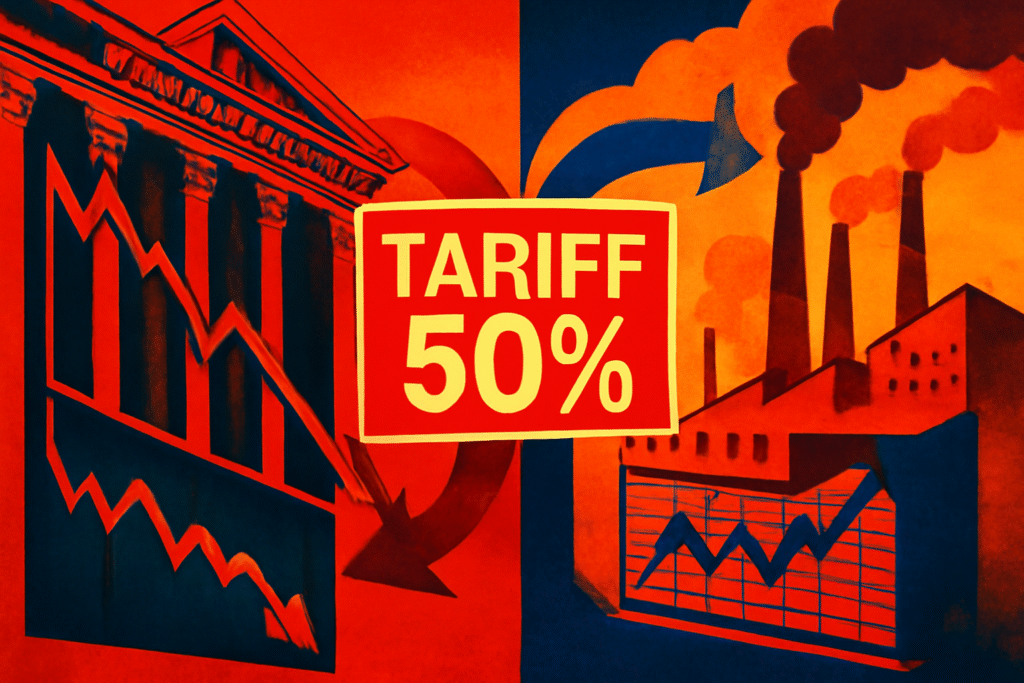Trump’s 50% tariff blow to India marks a dramatic turn in global trade, sending immediate shockwaves through both the stock markets and economic corridors of India and the US. With President Donald Trump announcing an additional 25% tariff on Indian imports—on top of the prior 25%—the total US tariff rate now hits a striking 50%. This move, as a penalty for India’s continued crude oil trade with Russia, surpasses even the punishing trade barriers the US set against China in recent years. For Indian investors and businesses, this announcement is more than just a news headline; it’s a game-changer that puts the spotlight squarely on key export sectors and broader market sentiment.

As news of the tariffs broke, India’s stock market braced for a sharp reaction, with most analysts predicting an immediate 1–2% drop as investors rush to reassess risk. Yet, seasoned experts like Dhiraj Relli from HDFC Securities point out that this knee-jerk dip may be short-lived. The 21-day grace period before these tariffs become effective offers a critical diplomatic window for potential resolution, and investors seem to be factoring in the hope for a last-minute reprieve. However, if this window closes without an agreement, the economic implications may grow larger than temporary market jitters suggest.
Export-heavy industries are in the crosshairs of these new tariffs. Textile powerhouses and readymade garment leaders like Gokaldas Exports and Kitex Garments, alongside engineering firms such as Bharat Forge and Sona BLW Precision Forgings, risk seeing a sudden freeze in US-bound orders. For these companies, high tariffs mean squeezed margins, likely production cuts, and a real threat of job losses, especially in labor-intensive sectors that were already operating under slim profits and intense international competition.
On a broader economic scale, economists warn that, should the tariffs stay in force for a year, India’s GDP could decline by 30 to 40 basis points. This loss comes at a sensitive time, as India positions itself for a cyclical upswing in the second half of FY26. There’s even speculation that India may weigh reducing Russian crude oil imports to ease US pressure. If that happens, Reliance Industries and government-run oil marketers would likely face steeper procurement costs, just as rising global oil prices ramp up inflation across the board.
Adding another layer of complexity, uncertainty around possible extended tariffs or even secondary sanctions could push global-facing stocks, such as Apple’s Indian EMS partners, into volatility. While some segments like electronics manufacturing services (EMS) and pharmaceuticals may be exempt for now, sentiment has already turned cautious among international investors. Seshadri Sen from Emkay Global advises investors to resist panic selling. Instead, for savvy market participants, a dramatic correction—especially a drop of over 5%—could open up rare buying opportunities in fundamentally robust sectors.
For those looking to shield themselves from volatility, Emkay recommends overweighting Consumer Discretionary and Industrials, which are supported by strong domestic demand and minimal exposure to US trade tensions. Meanwhile, Financials, Technology, and Consumer Staples may lag due to both global headwinds and challenges specific to their industries.
The way forward for India could hinge on its policy response. Any retaliatory tariffs from New Delhi might escalate the situation into a broader trade conflict, making the near-term outlook murkier for investors globally. Still, both countries’ strategic interests and deep economic links keep a diplomatic resolution on the table.
For investors, patience and discipline are vital amid uncertainty. Avoiding impulsive trades, focusing on long-term fundamentals, and staying alert to policy developments will separate winners from losers in this volatile period. As history shows, market storms often give way to clear skies for those who keep their perspectives—and portfolios—balanced and informed. India’s resilience, underpinned by domestic growth, may offer a silver lining even as global turbulence tests nerves.
